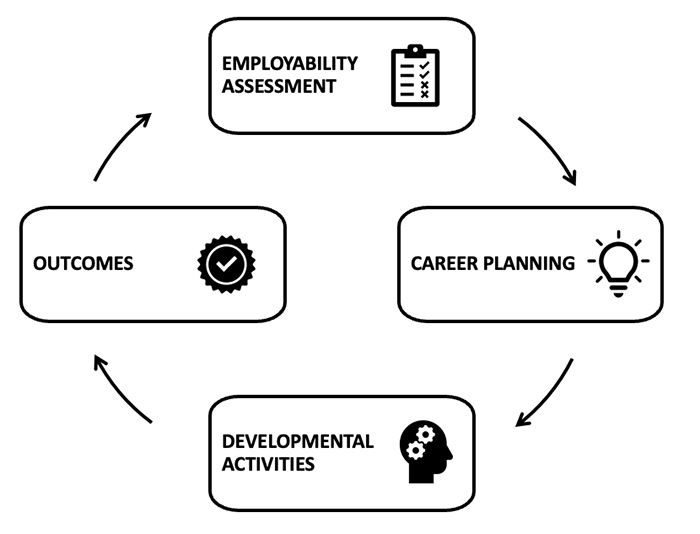A Process Model for Developing Employability
06/08/2024
Dr Jason Brown is Academic Program Director of Experiential Learning for the Faculty of Business and Economics at The University of Melbourne. Prior to commencing the research and teaching phase of his career, Jason was a career practitioner for over 20 years and was recipient of the CDAA Award for Excellence in Leadership in 2018. Jason was involved in designing and implementing an employability award program at La Trobe University in 2017.

In higher education, employability is generally defined as a set of skills or capabilities that enable graduates to obtain employment. There is a widely held belief that gaps exist between the skills graduates possess and what employers are seeking, and that the way to improve employment outcomes of graduates is by developing the skills that employers are seeking.
The solution is often to encourage students to complete an employability award program. However, employability awards are designed in absence of career development theory. This process model was developed to enable career development practitioners to design employability award programs using an evidence-based approach.
What is an employability award program?
Employability awards are programs that incentivise students to participate in activities to develop their employability, such as internships, volunteering, leadership roles within student clubs and societies, and career development learning. Students are required to complete a minimum number of these activities. When they do, they receive recognition such as a certificate of completion, digital badges, or a notation on their academic transcript or the Australian Higher Education Graduate Statement (AHEGS).
What’s the problem?
First, my research found that there is a tenuous link between employability skills and employment outcomes. In a study of 150,000 graduates over a three-year period, we found that there was a close to zero correlation between graduates’ perceptions of their skills and employment status. In other words, a large increase in their skills would result in just a tiny increase in the chances of being employed.
Secondly, employability awards are often designed in the absence of a theoretical approach. Most of the activities included in employability awards are not purposefully designed to develop employability. Most often, they are a curation of activities that students have been engaged in on university campuses for decades. There are mixed findings in the literature about how well extra-curricular activities and volunteering contribute towards employment outcomes.
Thirdly, students are required to follow the rules of the program, which is more about meeting minimum participation thresholds than it is about meeting specific development needs.
Process Model
The process model of employability was developed to aid career practitioners to design evidence-based programs to develop employability of students in educational settings. Whilst this model was designed in the context of higher education, it can be adapted for use in organisational settings or individual career coaching and counselling.
The model is informed by Mark Savickas’s Career Adaptation Model (part of Career Construction Theory) and Sue Whiston’s critical ingredients of successful career interventions. The process model provides guidance on designing career and employability development programs.
The focus is on development of employability from a perspective of psychosocial resources and human, social, psychological capital, rather than a narrow focus on the development of employability skills. Here are the steps you can take in designing an evidence-based employability program.

Figure 1. Process model of employability. © Jason Brown. Used with permission.
Step 1: Employability Assessment
Design an induction workshop or online module to introduce participants to the program. The induction should include:
- an overview of employability concepts
- strategies that contribute to obtaining employment
- an opportunity to complete a battery of questionnaires (e.g., AGRADES) to identify their employability-related development needs
Step 2: Career Planning
Offer a group or individual session to discuss the results of their employability assessment. Taking a strengths-based approach, encourage participants to:
- identify areas of strength as well as areas that would like to develop
- identify strategies to develop their employability, for example, building job search skills to increase their job search self-efficacy
- write an action plan that includes the development activities they will engage in to work towards their employability goals
Step 3: Developmental Activities
This step involves engaging in activities such as internships, volunteering, networking, career exploration, mentoring, and career coaching. Encourage participants to:
- keep records of activities engaged in
- record reflections of their experience
Step 4: Reflection on Outcomes
Qualitative and quantitative data can be used to support participants’ reflections.
- Qualitative: Participants may wish to reflect on how the activities enabled them to develop specific knowledge, skills, and other learning outcomes
- Quantitative reflection: Participants complete the employability assessment again and compare changes in scores
Work with your participants to:
- Review changes in scores across each scale in the questionnaire
- Note whether the changes are large or small, positive or negative
- Ask the participant why they think their score(s) changed, and which activity may have contributed to that change
- Look forward to how they continue to develop their employability
This process model serves as a guide for designing employability programs that draws on theory and established career development interventions to enable participants to identify developmental opportunities and to select activities that are appropriate for their developmental needs.